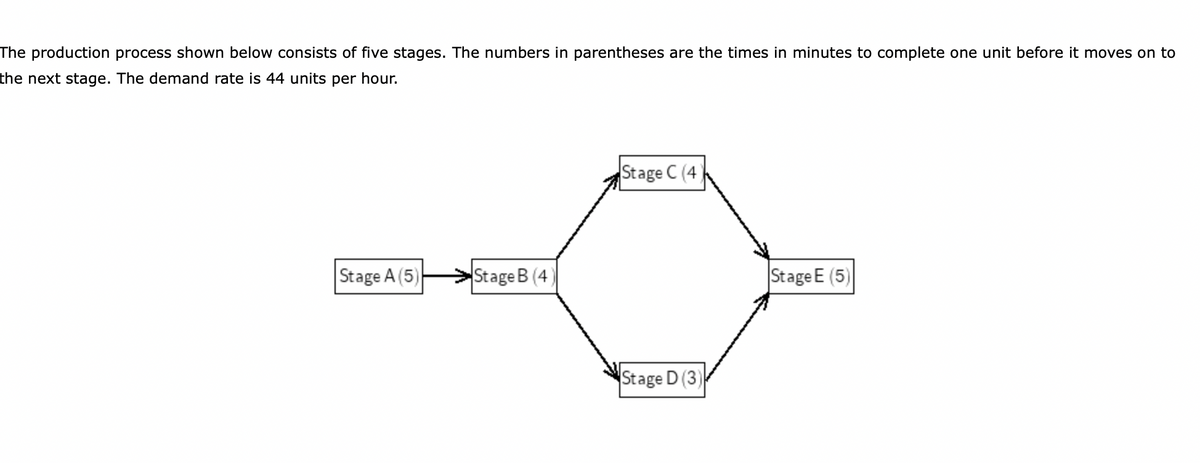a. How many workers are needed at each stage if management wants a utilization of at least 90 percent? Round your answers up to the nearest whole number. Stage A: workers Stage B: workers Stage C: workers Stage D: workers Stage E: workers b. Suppose that the number of workers at each stage are as follows: B Stage A Number of Workers 4 3 5 D E 2 6 IT What is the output rate at each stage? Round your answers to the nearest whole number. Stage A: units/hour Stage B: units/hour Stage C: units/hour Stage D: units/hour Stage E: units/hour c. Where is the bottleneck in this process? The bottleneck is -Select-
a. How many workers are needed at each stage if management wants a utilization of at least 90 percent? Round your answers up to the nearest whole number. Stage A: workers Stage B: workers Stage C: workers Stage D: workers Stage E: workers b. Suppose that the number of workers at each stage are as follows: B Stage A Number of Workers 4 3 5 D E 2 6 IT What is the output rate at each stage? Round your answers to the nearest whole number. Stage A: units/hour Stage B: units/hour Stage C: units/hour Stage D: units/hour Stage E: units/hour c. Where is the bottleneck in this process? The bottleneck is -Select-
Practical Management Science
6th Edition
ISBN:9781337406659
Author:WINSTON, Wayne L.
Publisher:WINSTON, Wayne L.
Chapter4: Linear Programming Models
Section: Chapter Questions
Problem 111P
Related questions
Question

Transcribed Image Text:The production process shown below consists of five stages. The numbers in parentheses are the times in minutes to complete one unit before it moves on to
the next stage. The demand rate is 44 units per hour.
Stage A (5)
Stage B (4)
Stage C (4)
Stage D (3)
Stage E (5)

Transcribed Image Text:a. How many workers are needed at each stage if management wants a utilization of at least 90 percent? Round your answers up to the nearest whole number.
Stage A:
workers
Stage B:
workers
Stage C:
workers
Stage D:
workers
Stage E:
workers
b. Suppose that the number of workers at each stage are as follows:
Stage
A
Number of Workers
4
B
3
C
5
D
2
E
6
☐
What is the output rate at each stage? Round your answers to the nearest whole number.
Stage A:
units/hour
Stage B:
units/hour
Stage C:
units/hour
Stage D:
units/hour
Stage E:
units/hour
c. Where is the bottleneck in this process?
The bottleneck is -Select- ÷
Expert Solution
This question has been solved!
Explore an expertly crafted, step-by-step solution for a thorough understanding of key concepts.
This is a popular solution!
Trending now
This is a popular solution!
Step by step
Solved in 3 steps with 8 images

Recommended textbooks for you

Practical Management Science
Operations Management
ISBN:
9781337406659
Author:
WINSTON, Wayne L.
Publisher:
Cengage,

Practical Management Science
Operations Management
ISBN:
9781337406659
Author:
WINSTON, Wayne L.
Publisher:
Cengage,